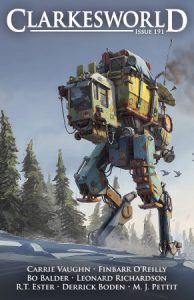Karen Burnham Reviews Short Fiction: Asimov’s, Future SF Digest,and Clarkesworld
 Asimov’s 7/8-22
Asimov’s 7/8-22
Future SF Digest 6/22
Clarkesworld 8/22
The July/August Asimov’s starts off with a novelette by Will McIntosh. “Work Minus Eighty” is set in the same universe as his novels Bridesicle and Love Minus Eighty. In this world dead women can be frozen and brought back to life if someone rich enough is interested in marrying them. Aurelia has worked her way up the ranks of the company that provides this service, and has truly convinced herself that she’s doing a good thing. When one of the bridesicles turns out to be an old friend of hers, and after she strikes up an unusual friendship with a protestor, doubts start to take root – and profitable corporations are loath to change. Michèle Laframboise’s “Screaming Fire” is a prequel novelette to the books in her YA Gardener’s Universe. Squad leader Dziunn leads a rescue mission on a planet that’s been razed by humans. He finds baby Plezar in a burning house and risks his own life to save the boy. It’s a romping adventure tale. Rick Wilber contributes novella “The Goose”, which continues his alt history series centered around baseball player Moe Berg and his different timeline incarnations. The story is mostly set in 1941 and involves baseball (of course), the unique Spruce Goose aircraft, a fascist plot among Nazi sympathizers in Hollywood, and others. It’s a lot to get into one story, but the novella is long enough that it doesn’t feel overly crammed. A stand-alone novelette by Megha Spinel, “The Secret of Silphium”, is set in 92 BCE, in a Roman province. Tamra is a linguistic genius working for Yosef, a Jewish scholar. People start coming in asking about silphium, the titular herb that seems to have miraculous healing properties. There are many intersecting interests, from the Roman legion to a potential non-human actor. There’s a recurring theme of freedom vs. slavery and how those layers make any kind of human relationship considerably more fraught. I very much liked the ending of this one, where it zooms out on the timeline to show how the actions of the characters in our past have a significant impact well into our future.
Among the shorter stories “Pollen and Salt” by Octavia Cade may be my favorite. It’s an elegiac piece about a woman mourning her husband while continuing her research on pollen in mudflats and salt marshes. She thinks through the past, the future, the evolution of people, and that of environments as water levels rise. It’s beautifully done. There is also an appropriately bleak story from K.A. Teryna (translated by Alex Shvartsman from Ukrainian into English), “The Tin Pilot”. It is set in a world where “golems” have been created to fight in the last war. Fully human in appearance, they were first welcomed home as important Heroes, then gradually came to be shunned as hated Others. Main character Noah has an identity crisis, unsure of his own past and whether he might be an amnesiac golem himself. It’s a sober reminder that the scars of war don’t disappear when the war ends.
Mr. Shvartsman of course also edits the excellent Future Science Fiction Digest, and in its fifteenth issue it is able to include 100% translated stories for the first time, with two stories from Ukraine and one each from Greece and China. “Rescue Rangers” by Henry Lion Oldie (translated by Julia Meitov Hersey) and “Déjà Loop” by Kostas Charitos (translated by Dimitra Nikolaidou & Victor Pseftakis) are a nice pair. Both deal with characters who take part in thriller narratives in unusual ways. In “Rescue Rangers” the narrator is part of a quartet infiltrating a top-secret facility – but then you zoom out through different layers of who is controlling the action. In “Déjà Loop” the narrator is a spy in an organization that recruits “premnesiacs” – people who can see just a few seconds into the future. This is a huge help in stopping things like the sale and smuggling of illegal plutonium – unless the other guys have premnesia on their side as well. When two people can each iterate through different futures searching for one where they come out on top, the titular “loop” risks becoming infinite. Both of these stories use their worldbuilding to nicely complicate their otherwise straightforward, generic plots.
My hands-down favorite of the issue, though, is “The Immaculate Ivory Tower” by Li Huayi (translated by Nathan Faries). The narrator is a researcher looking at “wandering” or “planetary” “elephants” that seem to be appearing, seemingly dead, on various planetary surfaces. Everything about them is stunning, from their fabulous pelts to their better-than-ivory tusks, one of which forms the tower of the title. They’re also stupendously large, with some as large as all of Hong Kong. As the narrator and their research partner continue their investigations, however, they start to narrow in on where these beings are coming from, and why they appear deceased. The story starts to read more like an elegy, as all of these beings are taken for processing into luxury goods. This is a beautifully told fable of our Anthropocene times, with poetic and lush descriptions throughout.
August’s Clarkesworld starts out with a well-done clash-of-cultures story in “Tender, Tether, Shell” by M.J. Pettit. After an accident killed Tess but left her spacesuit intact, the alien Hae’cera occupied it to survive. Back safe in the station, her human colleagues are getting increasingly disturbed by continuing to see their crewmate’s spacesuit being piloted around by another being. The narrator is tapped to go talk to the hermit-crab-like alien, and through dialog they get a better understanding of each other. Things go considerably less well in “The Pirate’s Consigliere” by Bo Balder. Katla is the titular consigliere to a band of degraded human space warriors, who are surviving largely off raids and cannibalism, wearing human skins. When they meet an incoming spaceship that traveled slowly from Earth, the leaders assume they’ll be weak, easy pickings – but Katla, considerably smarter than those she serves, quickly realizes they’re more powerful than they look. Can she serve as a bridge between the two groups – and can she survive the process?
Carrie Vaughn brings us an adventure novelette in “Polly and (Not) Charles Conquer the Solar System”. Polly is from a powerful Founder family on Mars, but she’s been trying to make her own way on space crews. Her brother Charles went into politics, so when she starts seeing news articles that he’s in the hospital, but there are no pictures or interviews with him, she’s pretty sure something nefarious is afoot. With help from sympathetic officers in the fleet she returns to Mars and launches a one-woman rescue operation. Vaughn’s plotting throws up and knocks down obstacles with ease, and Polly is a nicely sympathetic hero. The issue ends with something completely different in “Migratory Patterns of the Modern American Skyscraper” by Derrick Boden. Told from a collective first person “we” POV, this future has nanotech housing that can go up in a week – then down again when it senses it’s better to move on. The story starts in San Jose CA where people are supremely grateful for the housing. Then it moves, again and again – some community members stay, others peel off, and the real question is, where is it going? It’s a creative musing about the state of work & life around some of the most high-cost urban areas of the planet.
Recommended Stories:
“Migratory Patterns of the Modern American Skyscraper”, Derrick Boden (Clarkesworld 8/22)
“Pollen and Salt”, Octavia Cade (Asimov’s 7-8/22)
“The Immaculate Ivory Tower”, Li Huayi (Future SF Digest 6/22)
“Tender, Tether, Shell” M.J. Pettit (Clarkesworld 8/22)
“The Secret of Silphium”, Megha Spinel (Asimov’s 7-8/22)
This review and more like it in the October 2022 issue of Locus.
 While you are here, please take a moment to support Locus with a one-time or recurring donation. We rely on reader donations to keep the magazine and site going, and would like to keep the site paywall free, but WE NEED YOUR FINANCIAL SUPPORT to continue quality coverage of the science fiction and fantasy field.
While you are here, please take a moment to support Locus with a one-time or recurring donation. We rely on reader donations to keep the magazine and site going, and would like to keep the site paywall free, but WE NEED YOUR FINANCIAL SUPPORT to continue quality coverage of the science fiction and fantasy field.
©Locus Magazine. Copyrighted material may not be republished without permission of LSFF.







